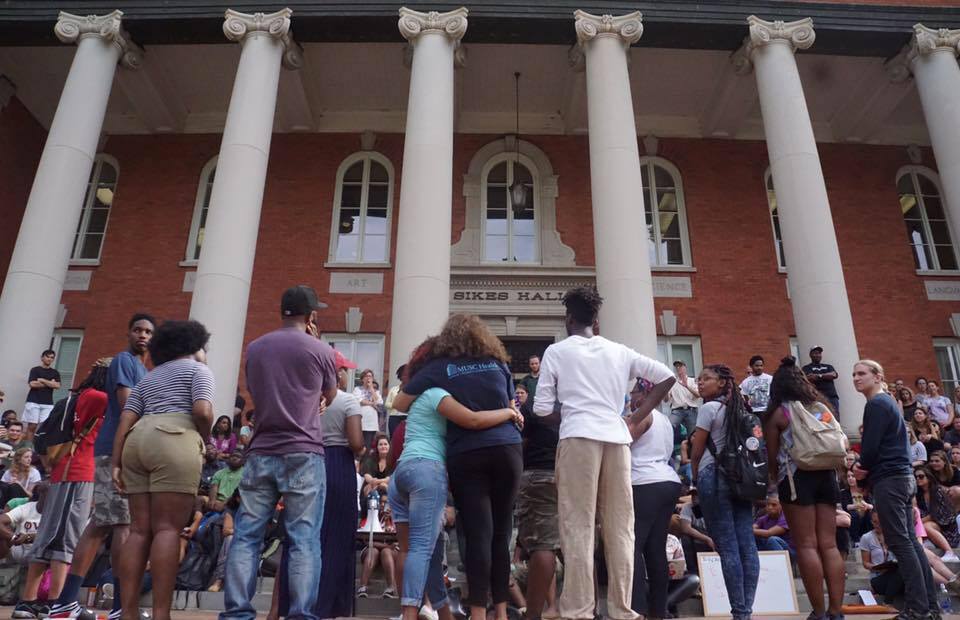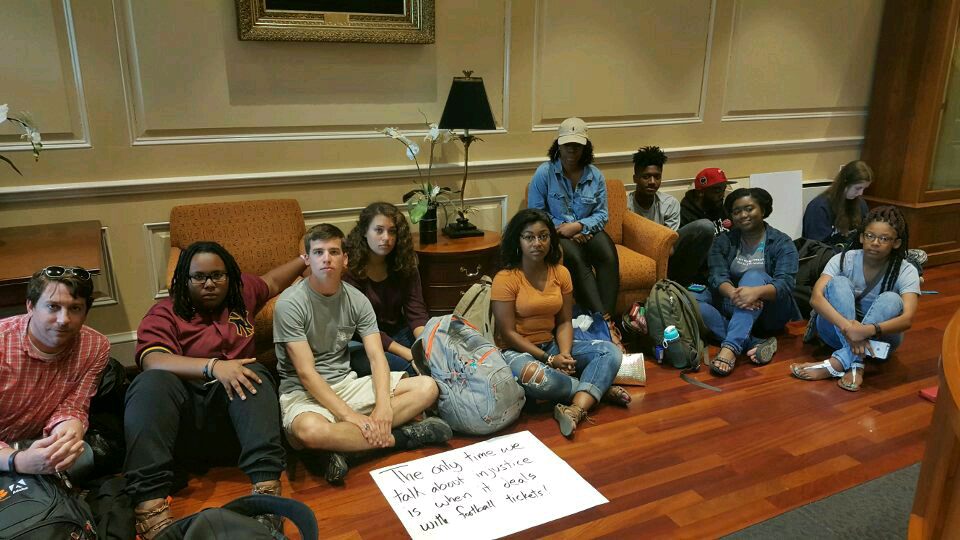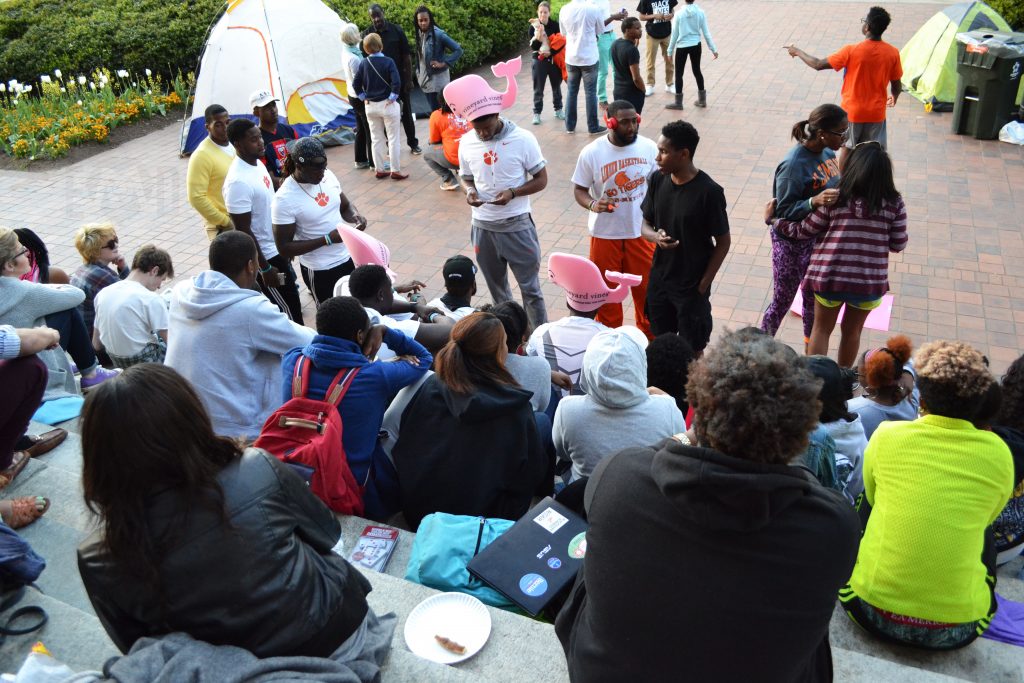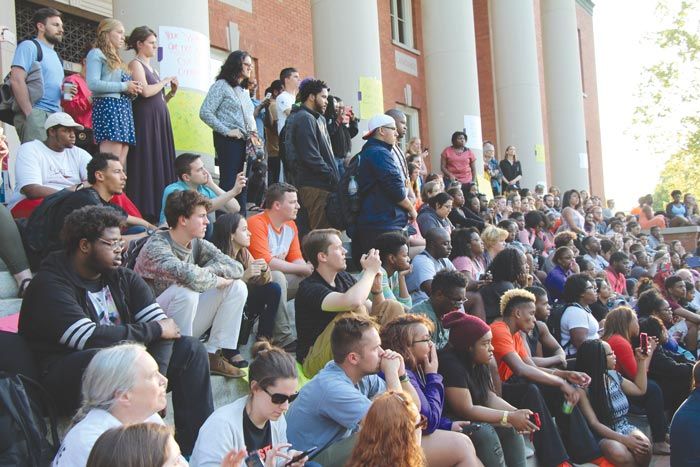On March 3rd I successfully defended my dissertation, which was my final official obligation to Clemson University before I graduate in May. The auditorium in which I defended was filled to capacity with students, faculty, alumni, and administrators who seemed genuinely interested in my project. It was a great feeling, honestly. Among many other things written to highlight my dissertation, one of the university’s official social media accounts referred to me as an “innovative Tiger.”
Just a little over a year before that date Clemson University administrators had me and four other students arrested. That was the second day of the Sikes Sit-In at the administration building on campus. What a difference a year makes.
At this time last year I was one of many Clemson students, staff, faculty, and community members who made the front of Sikes Hall home for nine days. There was certainly organizing work being done at Clemson before April 2016 that should be acknowledged, but the Sikes Sit-In is an important event in Clemson’s history that deserves commemoration.
It would be irresponsible, for a number of reasons, to leave that commemoration up to anyone who was not out there with us for those nine days. Five of us were arrested, but there were many more who organized, made signs, brought food, donated supplies, and made sure things went smoothly. While many slept outside, others sat awake in shifts watching over the group through the night for safety. There were folks who taught classes, some who provided entertainment, and others who just came out to support who should also be acknowledged. Though some of their names appear in stories about the sit-in many people who should be recognized are consistently left out of the narrative. Bre Ryans, D.J. Smith, Jessica Houston, Edith Dunlap, Katrice Robertson, Khayla Williams, Nia Ávila, Rae-Nessa White, Remy Barnwell, Richelle Hayes, Sherman Jones, Sadie Vaughn, La’Portia Perkins, and Ian Anderson are the first that come to mind because they were all there before, during, and after the sit-in (though they aren’t the only people whose names are often omitted).
People seem to be interested in progress narratives in which they can, after the fact, say something significant was accomplished. It feels good to see an underdog win. If the underdog doesn’t win then we look for something significant to tell ourselves it was all worthwhile.
It should be noted that students, along with some staff and faculty were doing organizing work long before the sit-in and long before I arrived on campus. Perhaps the work was less visible, but it is no less noteworthy. Those stories are important to remember. It is clearly evident the sit-in was effective, and the Clemson community has been changed by the student activism online and on campus. It’s important to acknowledge and continue to support the tremendous genuine political organizing efforts that have come to the fore since Sikes, and the numerous political organizing activities that have occurred in its wake. Less important, and less interesting, are those parasitic players who used the sit-in as yet another means by which to build their own personae on the backs of people of color, women, and other marginalized communities at Clemson. The genuine concerns of the students who put so much on the line by participating in a sit in the week before exam week are far more important. That, at Sikes, people felt a real sense of love and community at Clemson, if only for nine days, is important. That we found hope and felt its significance when calling that space the new Clemson University Political and Multicultural Center because we knew, really, that Clemson had no real desire and was not interested in making any plans to construct an actual multicultural building on campus is significant.
No, things have not gotten significantly better at Clemson.
There may be significantly more “political activity” on campus, but the upper administration is still as apathetic, unyielding, and ultimately unbothered by the fact that Clemson boasts an 84% white undergraduate student body from which the Ku Klux Klan feels it can — so it continues to try to — recruit. It’s significant that the online biographies of the slaveholders and white supremacists who ran the plantation and founded the university on these grounds have been altered to better reflect some of the more troublesome aspects of their lives. It seems the university also placed a marker outside of the Old Main building with some information about when it was renamed to honor the murdering terrorist Benjamin Tillman. His name remains on the building, though many people now refer to it as Old Main. It’s also significant that several football players supported and participated in the sit-in, but Death Valley, the field upon which they labor, still stands in the shadow of the Fort Hill Plantation House. Earlier this year they assembled a championship run that reportedly earned Dabo Swinney $1.4 million in bonuses as their overseer.
The past bleeds into the present and we remain ill-equipped to talk about it in any responsible way because we apparently believe it’s better left unsaid. Clemson is likely to acknowledge the sit-in happened. It is impossible for them to deny it at this point. Still, some people will be tempted to say it was all about the rotting bananas left on the “African-American Experience” poster outside the plantation house. Few will mention the many demonstrations and protests in the preceding years. The Crip’Mas Party, like the Blackface Party, will likely be forgotten until another fraternity or sorority is caught again publicly boasting about the same things they’ve been doing for generations here. We will conveniently look away from that, as well as the working conditions of the staff, and we will ignore the faculty fleeing to better positions at universities that will hopefully value them more. [To my understanding, at least six tenure-track Faculty of Color have left since I’ve been here; three of those will be leaving after this semester.] And eventually members of the so-called Clemson Family will be right back in the same place doing this very familiar thing all over again (like the professors and students who participated in the Fast and March for Justice earlier this spring after the Muslim ban).
I am not as interested in the narrative that highlights how much better we are now than we were then. If that was something I needed I would be leaving Clemson with a sadness related to the fact that not much has really changed at the institutional level. But I can leave proud of what happened at Sikes.
The nine days of the sit-in at Sikes is the only time many of us who were there ever felt a part of the community at Clemson. Those people are my version of the Clemson Family. I know, now, that Clemson University has no interest in that kind of family, that kind of community, even if it is interested in the appearance of such. None of this is new information. I’ve said it to every member of the administration to whom I have spoken, and I would say the same things to them today.
So many things, good and bad, have happened here since Sikes. It’s hard to believe it’s been a year since we were on those steps. Some days it feels like it all happened just last week, and that’s why not much has changed. Other days it feels like it was years ago, and we’re long overdue to get back out there and demand once more that the university be true to its words. It’s strange knowing I won’t be here next year. What’s more strange is to think that many others who were out there won’t be at Clemson, either. Even more, I know Clemson will attempt to co-opt what happened last spring and recast it as “the type of environment Clemson fosters” or some other revisionist narrative in which they take credit for progress on campus, and many people will believe it. That isn’t, and won’t ever be, true. But we’ll hardly see the version of events that come from the people who were out on those steps and who have been here trying to hold a mirror up to this so-called Solid Orange Tiger so it might see its dark stripes (both historic and contemporary). Eventually, this too may sadly become a Solid Orange story.
I guess when that happens you’ll just have to take our word that it wasn’t. We know because we were the stripes.





Good stuff, man. Clemson will miss you in more ways than one, but we are glad you came. Your work has set a standard.